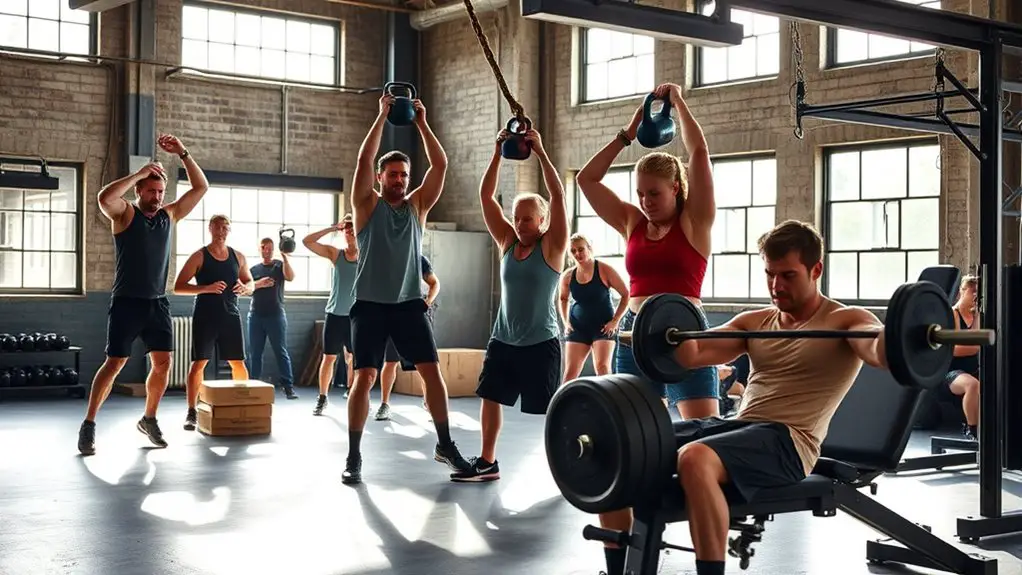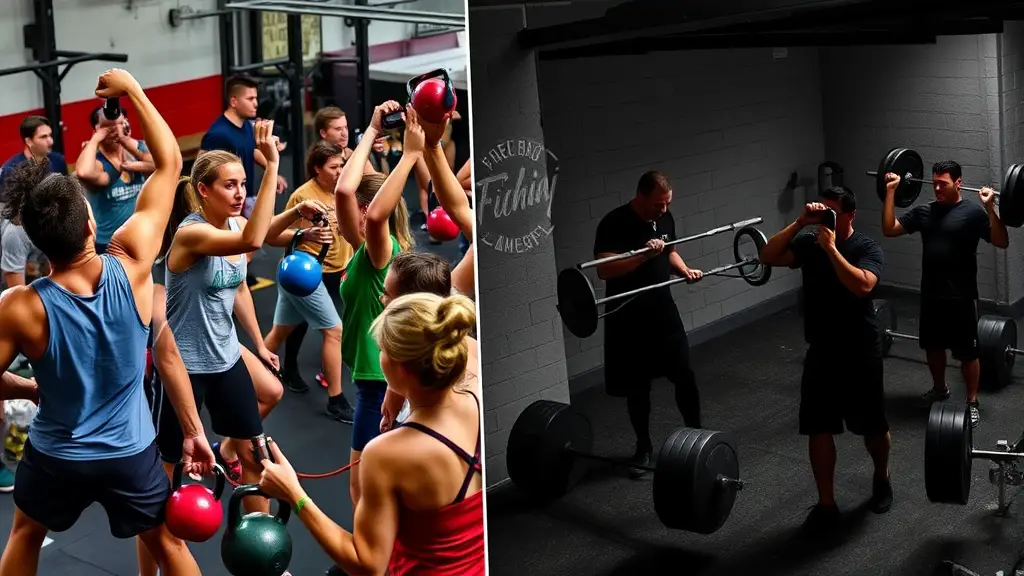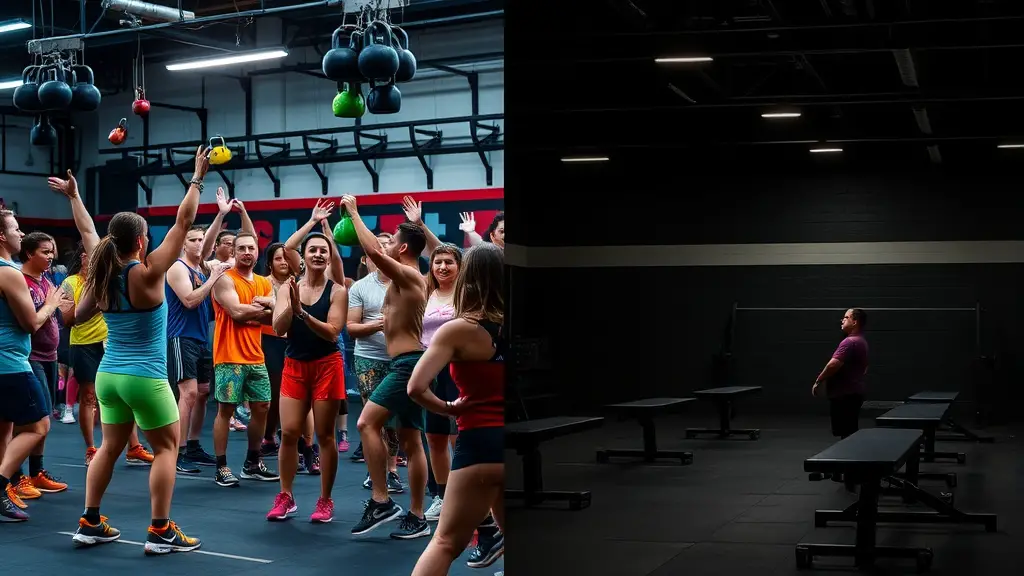How Crossfit Differs From Traditional Strength Training

CrossFit differs from traditional strength training by prioritizing high-intensity, varied workouts that focus on functional fitness. While traditional strength training emphasizes progressive overload and isolates muscle groups, CrossFit incorporates a mix of weightlifting, gymnastics, and cardio in a supportive community setting. This fosters competition and camaraderie among participants. Fundamentally, CrossFit builds overall athleticism, while traditional training hones in on raw strength. To explore the nuances of each approach, there’s much more to contemplate.
Philosophy and Goals

When you plunge into the world of fitness, understanding the philosophy and goals behind CrossFit and traditional strength training can shape your approach. CrossFit emphasizes varied, high-intensity workouts designed to improve overall performance outcomes, focusing on functional movements and adaptability. This training mindset encourages you to embrace challenges, fostering a sense of community and competition.
In contrast, traditional strength training prioritizes progressive overload to build muscle and strength systematically. Its goals are often more specific, targeting particular muscle groups and focusing on form and technique. This method cultivates discipline and patience, as you track your progress over time.
While both approaches yield impressive results, your choice depends on your personal goals. Are you seeking a diverse workout routine that enhances athleticism, or do you prefer a structured, strength-focused regimen? Knowing these philosophies will guide you in selecting the right path for your fitness journey.
Training Methodology
While both CrossFit and traditional strength training have their merits, their training methodologies differ markedly in structure and execution. CrossFit emphasizes functional fitness, focusing on movements that mimic everyday activities. You’ll engage in high intensity workouts that combine various elements like weightlifting, gymnastics, and cardiovascular training, all aimed at building overall athleticism.
In contrast, traditional strength training typically revolves around isolated muscle groups, with a more linear progression in lifting heavier weights over time. You might find yourself using machines or free weights in a steady routine that prioritizes strength gains over endurance or versatility.
CrossFit’s approach fosters a community atmosphere, often pushing you to compete against others or yourself, while traditional methods may focus more on individual progress. Ultimately, your choice between these methodologies will depend on your fitness goals, whether you’re seeking to enhance functional capabilities or increase raw strength.
Workout Structure

Although both CrossFit and traditional strength training have structured workouts, they differ greatly in how those workouts are organized and executed. In CrossFit, you’ll encounter varied routines that emphasize high workout intensity over a shorter workout duration. You might find yourself performing a mix of strength and cardio exercises in a single session, pushing your limits and maximizing calorie burn.
In contrast, traditional strength training typically focuses on:
- Set and rep schemes: More structured sets for muscle building.
- Workout duration: Longer sessions dedicated to specific muscle groups.
- Rest intervals: Extended breaks to recover between heavy lifts.
- Progressive overload: Gradual weight increases to build strength over time.
These differences affect not just your physical results, but also your overall gym experience. Understanding these variations helps you choose the right approach for your fitness goals.
Equipment and Movements
The equipment and movements used in CrossFit and traditional strength training play an essential role in shaping your workout experience and results. In CrossFit, you’ll encounter a diverse array of equipment, from kettlebells for swings and snatches to barbells for Olympic lifts like the clean and jerk. This blend of tools encourages functional fitness, pushing you to use your body in dynamic ways. Traditional strength training, on the other hand, often focuses on specific machines or free weights, emphasizing isolation exercises to build muscle.
While both methodologies enhance strength, CrossFit’s emphasis on compound movements promotes overall athleticism and endurance. You’ll find that kettlebell swings engage multiple muscle groups, improving both strength and coordination. If you’re looking for a workout that challenges your body in varied ways, CrossFit’s innovative use of equipment and movements might be just what you need to break through plateaus and achieve your fitness goals.
Community and Culture

When you step into a CrossFit gym, you immediately sense a unique community spirit that sets it apart from traditional strength training environments. This culture fosters a strong sense of belonging and motivation, driven by community engagement and a competitive spirit.
Here are some key aspects of the CrossFit community:
- Supportive Atmosphere: Members cheer each other on, creating an encouraging environment.
- Shared Goals: Everyone works towards personal bests, fostering camaraderie.
- Inclusive Events: Competitions and social gatherings bring members together, strengthening bonds.
- Diverse Membership: People of all fitness levels and backgrounds unite, enriching the community.
This combination of support and competition not only enhances your workout experience but also cultivates lasting friendships. In contrast to the often solitary nature of traditional strength training, CrossFit thrives on collaboration and collective achievement, making each session feel like a shared journey.
Frequently Asked Questions
Can Crossfit Help With Weight Loss Faster Than Traditional Strength Training?
Yes, CrossFit can potentially help you lose weight faster due to its focus on metabolic conditioning and high workout intensity. The varied, high-energy workouts elevate your heart rate, burning more calories during and after sessions. Traditional strength training, while effective, often prioritizes muscle building and may not maintain the same level of intensity. If your goal’s weight loss, CrossFit’s dynamic approach might be the more efficient choice for you.
Is Crossfit Suitable for Beginners With No Prior Fitness Experience?
You might think CrossFit’s too intense for beginners, but it’s actually quite accessible. Many gyms offer beginner modifications, ensuring you can participate at your own pace. The supportive fitness community fosters encouragement, helping you build confidence and skills. With tailored workouts and guidance from coaches, you’ll find it’s a great way to start your fitness journey, allowing you to gradually progress while enjoying the camaraderie that CrossFit offers.
How Does Crossfit Address Injury Prevention Compared to Traditional Training?
CrossFit addresses injury prevention through thorough injury assessment and mobility training. You’ll find that workouts often incorporate dynamic warm-ups and flexibility exercises, helping you improve your range of motion. Coaches focus on your form, ensuring you’re using proper techniques to reduce strain. By emphasizing functional movements and adaptive strategies, CrossFit encourages a holistic approach to fitness that prioritizes your safety while still promoting strength and endurance gains.
What Nutrition Strategies Are Recommended for Crossfit Athletes?
Did you know that around 70% of CrossFit athletes prioritize their nutrition? For ideal performance, you should focus on macronutrient balance, aiming for a mix of proteins, carbs, and fats tailored to your workout intensity. Additionally, hydration strategies are essential; staying well-hydrated can enhance endurance and recovery. Incorporating these elements into your routine can greatly impact your performance and help you achieve your fitness goals effectively.
Are Crossfit Workouts More Time-Efficient Than Traditional Strength Training Sessions?
Yes, CrossFit workouts can be more time-efficient than traditional strength training sessions. With a focus on high-intensity, varied exercises, you can maximize your workout in a shorter period. This variety keeps you engaged and challenges different muscle groups, which can lead to quicker gains. Effective time management is essential, and CrossFit’s structure often allows you to complete an all-encompassing workout in under an hour, making it ideal for those with busy schedules.





